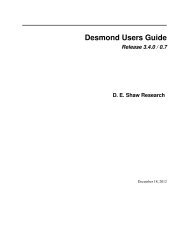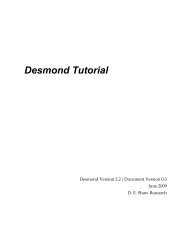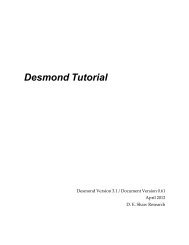Desmond Tutorial
Desmond Tutorial - DE Shaw Research
Desmond Tutorial - DE Shaw Research
- No tags were found...
You also want an ePaper? Increase the reach of your titles
YUMPU automatically turns print PDFs into web optimized ePapers that Google loves.
<strong>Desmond</strong> <strong>Tutorial</strong><br />
Finishing Preparations for <strong>Desmond</strong> Simulation<br />
Figure 5.2 Advanced Options for simulation jobs<br />
Parameters for nonbonded<br />
interactions.<br />
Thermostat and<br />
barostat parameters.<br />
Controls output files<br />
for simulations.<br />
Parameters for<br />
setting harmonic<br />
restraints.<br />
Other parameters<br />
such as those<br />
defining atom<br />
groups.<br />
Multiple time step<br />
parameters and<br />
constraints.<br />
The Advanced Options window has several tabs:<br />
• Ensemble—Contains thermostat and barostat parameters.<br />
• Interaction—Contains parameters for computing non‐bonded interactions.<br />
• Restraint—Provides a table in which multiple sets of atoms can be subjected to harmonic<br />
restraint with a user‐defined force constant. Atom selection can be directly<br />
input as an ASL expression or you can click the Select button to bring up the Atom<br />
Selection dialog box.<br />
• Output—Includes the names of various <strong>Desmond</strong> output files, and allows you to<br />
specify how often these files are updated during the simulation. For example, different<br />
energy terms are recorded in the energy sequence file in user‐defined intervals.<br />
Snapshots of the simulation are periodically saved in the trajectory file and the<br />
entire simulation state is also saved at user‐defined intervals in a checkpoint file.<br />
<strong>Desmond</strong> simulations can be restarted from checkpoint files with bitwise accuracy.<br />
• Misc—Provides control over miscellaneous parameters, including the definition of<br />
atom groups. Currently, two different atom groups are recognized by <strong>Desmond</strong>. A<br />
`frozenʹ atom group means a set of atoms that move during the entire MD simulation<br />
as a rigid body. (NOTE: in <strong>Desmond</strong>, unfrozen atoms cannot be connected to<br />
frozen atoms). For example, an entire protein molecule can be frozen (during equilibration),<br />
but one cannot freeze only the heavy atoms, or just certain residues. In that<br />
case, restraints should be used. Also note that frozen atoms cannot be used with<br />
NPT simulations, because the Virial will be incorrect. The other atom group termed<br />
cm_moi is used to define parts of the system whose center of mass motion is set to<br />
zero. In most protein simulations the protein center of mass motion is set to zero to<br />
prevent the protein from translating and rotating in the simulation box. Atom<br />
62 D. E. Shaw Research September 2008






